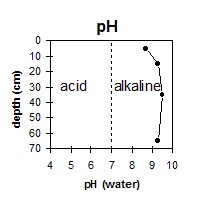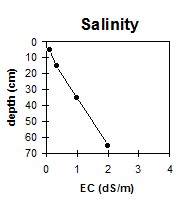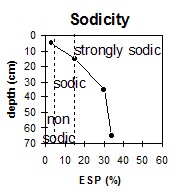MP21
| Australian Soil Classification: Hypercalcic, Effervescent (& Mesonatric), Red SODOSOL | |
| Location: Pirlta | General Landscape Description: Flat |
 MP21 landscape |
Soil Profile Morphology:
Surface Soil
| A1 | 0-10 cm | Yellowish red (5YR5/6); fine sandy clay loam; loose surface condition; weak coarse blocky structure; weak consistence dry; slightly calcareous; pH 8.7; gradual change to: |  MP21 profile |
| Subsoil | |||
| B21 | 10-20 cm | Yellowish red (5YR5/6); medium heavy clay; strong medium prismatic, parting to strong very fine prismatic structure; strong consistence dry; contains a few (2-10%) soft carbonates; very highly calcareous; pH 9.3; sharp change to: | |
| B22k | 20-50 cm | Yellowish red (5YR5/6); medium heavy clay; moderate coarse prismatic, parting to strong medium blocky structure; strong consistence dry; contains many (20-50%) soft carbonates; very highly calcareous; pH 9.5; clear change to: | |
| B23 | 50-80 cm | Reddish yellow (5YR6/6); heavy clay; strong coarse blocky structure (smooth faced peds); very strong consistence dry; contains very few (<2%) soft carbonates and dark stains; very highly calcareous; pH 9.3. | |
Key Profile Features:
- Strong texture contrast between surface (A) horizons and sodic subsoil (B21) horizon
- Very strongly alkaline profile throughout.
- High accumulation of carbonate within the subsoil.
|
Whole Profile
- The strongly alkaline profile suggest that some nutrients (e.g. manganese, zinc, iron, copper) may be poorly available to plants. Nutrient deficiencies can be assessed by plant tissue analysis. Plant species should be chosen in accordance with this pH level.
- The high inherent fertility throughout the profile is very beneficial to plant growth. The calcium levels in the surface and upper subsoil are also high and is beneficial to plant nutrition as well as in improving soil structure.
Surface (A) Horizon
- The surface soil has a high fine sand content. Soils such as these rely to a large extent on organic matter for maintaining aggregation. The levels of organic carbon measured at the pit site (which may or may not be representative of the whole paddock) is low. Organic matter will build up under pasture but will decline if cultivation takes place. Practices such as residue retention, minimum tillage and including pasture rotations could be utilised if cropping takes place in order to build up organic matter.
- The upper subsoil is non-sodic, however the soil disperses moderately after remoulding and is likely to restrict root and water movement somewhat. This indicates that tillage or over-stocking of the soil whilst in a moist to wet condition may result in structural degradation occurring (e.g. surface sealing, increased clodiness). Raindrop action on bare soil may have a similar effect, so it is important to maintain surface cover. Increasing organic matter levels will also help to improve these characteristics as well as assisting in soil aggregation.
- The levels of total nitrogen measured at this pit site is low. However, this is best assessed by taking a bulked sample from across the paddock.
Subsoil (B) Horizon
- The coarsely structured subsoil below 15 cm depth becomes strongly sodic and has a low exchangeable calcium to magnesium ratio (ie. 0.4 at 20 cm). Dispersion occurs as a result restricting root and water movement, however, with the increase of salt levels going down the profile the dispersion decreases accordingly. Deep ripping into the subsoil may help to break up the physical structural problems and the application of gypsum would help to neutralise the sodic problems. This expensive option would firstly depend on expected crop yield and also on adequate rainfall, to wash the gypsum down the deep rips into the subsoil. As the surface soil is quite shallow, gypsum could also be added to the surface without deep ripping, but it would require more time to wash the gypsum down to the subsoil as the subsoil is sodic and dispersive then disturbance to the soil (by tillage or ripping) should be avoided if it is wetter than the plastic limit as this may result in structural degradation occurring.
- The salinity rating becomes high at about 35 cm and increases to an extremely high level about 70 cm depth. These levels of soluble salts are very likely to restrict the growth of salt sensitive plant species (e.g. faba beans, linseed, chickpeas and lupins).
- The high level of exchangeable sodium and magnesium in the deeper subsoil may also result in nutrient imbalances and may have a toxic effect on some plants.
Comments:
- At time of soil sampling (October 1994) the site had not been cropped for 6 years, but grew good wheat crops before that time.





